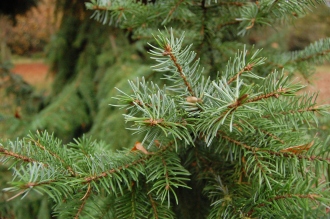Position: Full Sun
Flowering period: Spring (insignificant)
Soil: Well drained, moist
Eventual Height: 35m
Eventual Spread: 5m
Hardiness: 4a, 4b, 5a, 5b, 6a, 6b, 7a, 7b, 8a, 8b, 9a
Family: Pinaceae
Picea omorika is a medium sized, fast growing evergreen tree with a slender, columnar, upright growth habit. The leaves of the plant are needle like, up to 20mm long, flattened in cross section and dark blue green above and blue white below. The trunk may achieve a diameter of 1m. The bark of the tree is red brown in colour and develops big, rounded scales. Non showy purple monoecious flowers appear in spring. The cones are up to 7cm long, spindle shaped, dark purple when young maturing to dark brown 5 -7 months after pollination in autumn.
Picea omorika, commonly known as the Serbian Spruce, is endemic to the Drina River valley in eastern Bosnia and Herzegovina near Visegrad and western Serbia. It was originally discovered near the village of Zaovine on the Tara Mountain in 1875, and named by the Serbian botanist Josif Pancic. P. omorika was introduced into the UK in 1889. It is considered to be endangered in it’s native environment according to ‘The IUCN Red List of Threatened Species‘
The etymological root of the binomial name Picea is derived from the Lain Pix meaning ‘pitch or tar’ in reference to the Spruce trees resin. Omorika is derived from the Serbian meaning ‘Spruce’.
Picea omorika may be useful to the landscape architect as a dramatic avenue tree, due to it’s upright, columnar habit, similar to that of the Italian Cyprus. Due to it’s tolerance of urban pollution it is suitable for use as a street tree. It may also be useful when space is restricted, assuming light conditions are acceptable. It needs to be sheltered from cold drying winds.
Ecologically Picea omorika provides a place of refuge for many birds and some mammals.
Picea omorika has been awarded the prestigious Royal Horticultural Societies annual Award of Garden Merit in 1993.
Picea omorika prefers moist, well drained loam soils. It will tolerate alkaline soils (unusually for a Spruce).
Picea omorika requires little maintenance.







Leave a comment